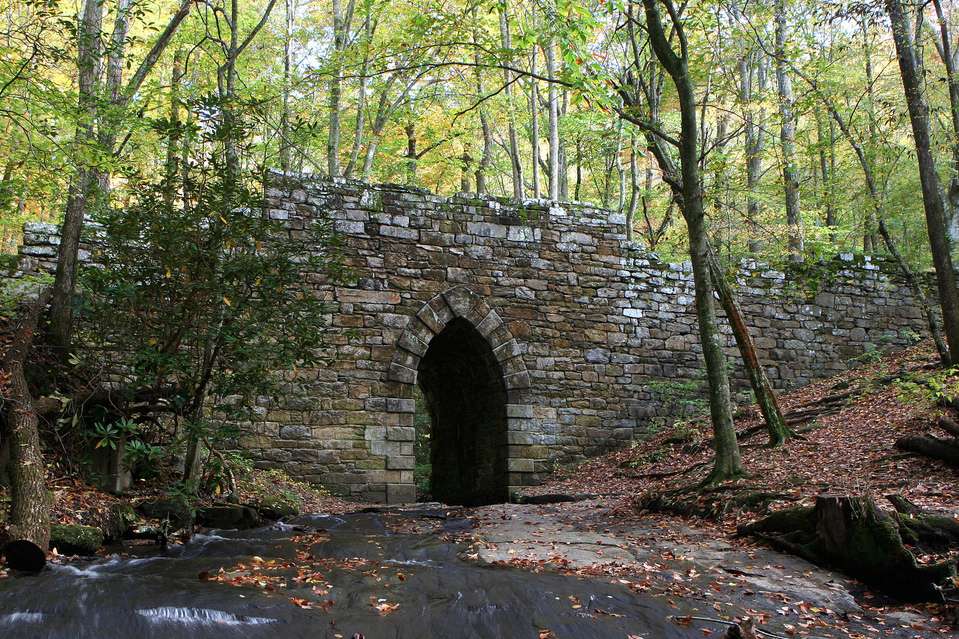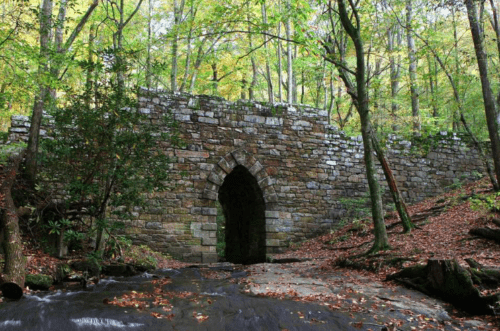Today the old but astonishing bridge looks completely out of place.
The grand, stone Gothic arch of Poinsett Bridge stands in stark contrast to an otherwise ordinary grove of poplar and oak trees.
In other words, this dignified and historic structure is all but “hidden in a patch of unmarked forest in the mountains of northwestern South Carolina.”

But truth be told, when it was built, Poinsett Bridge was just one small part of the larger State Road meant to connect Charleston up to Columbia and Upstate South Carolina up to Western North Carolina.
By 1820, overseers of this state-spanning project — the South Carolina Board of Public Works — had made their way to northern Greenville County’s section of the State Road, which went by the name Saluda Mountain Road.
To ensure safe passage over northern Greenville’s rivers and creeks, the board constructed a total of three bridges along Saluda Mountain Road, including Poinsett Bridge.
Though the project at Saluda Mountain Road, in particular, no doubt required concerted efforts from a great number of hired hands, it was not quite as large a sum as for other sections of the State Road.
Around 500 workers completed the 11-mile Saluda Mountain Road — which began on the northernmost level land at the foot of the mountains and stretched up to the Carolina border — in less than four months.
While the original plans for the bridge have been lost, the official historical report by the South Carolina Department of Archives and History credits South Carolina-born architect Robert Mills with the design of the bridge.
A native South Carolinian, Mills designed more than 50 major works during his lifetime, including colleges, hospitals, bridges, and several buildings of national significance. He’s responsible for the Washington Monument and the Treasury Building in D.C.
The report notes, too, that it’s equally likely that Mills’ predecessor with the South Carolina Board of Public Works, William Jay, was responsible for the design.
Less uncertain is the man for whom the bridge was named. Joel Roberts Poinsett, a prominent South Carolina politician, was, at the time, president of the South Carolina Board of Public Works.
Poinsett was perhaps best known during his lifetime as a member of Congress and U.S. ambassador to the country of Mexico. Today, however, he’s more likely to be remembered as the namesake of the poinsettia flower, which he introduced to the U.S. And, to Greenville County locals, he’s also the namesake of The Westin Poinsett, Greenville hotel and Poinsett Highway.
According to the stone marker located on the south side of the bridge, Poinsett and also Abram Blanding, the South Carolina Board of Public Works’ acting commissioner, were involved in organizing the building of Poinsett Bridge, as well.
But who actually built the bridge?
Work on the State Road originally began in the Lowcountry and then moved up toward the mountains. Many of the same crew members worked all along the way between there and here.
“They came on ships down the Atlantic Ocean into Charleston and traveled the rest of the way by wagon,” said Tami Owens, whose family has lived in the Upstate for generations.
While State Road crew consisted of skilled laborers from the North, the ordinary laborers involved in the project truly came from all over the country, including from local Carolina communities.
“Some of these men boarded with the Callahan family,” added Owens.
The Callahans owned a cabin a short distance from the site of Poinsett Bridge; this cabin served as a headquarters of sorts for the building crew while they worked on the bridge.
This cabin eventually changed hands to John H. Goodwin, whose family occupied it up to the 1940s. Boy Scouts bought the cabin and around 300 surrounding acres in 1927 for a camp site, which they named Camp Old Indian.
Of the three bridges built along Saluda Mountain Road, only Poinsett Bridge remains today. In fact, the bridge is not only the oldest surviving bridge in the state of South Carolina, but also perhaps the oldest in the Southeast region.
The bridge served its purpose in connecting Charleston, the Upstate and North Carolina for over 100 years, and then newer and better roads took its place. Today, only foot traffic crosses over its faithful rocks.
Poinsett Bridge earned its place among the National Register of Historic Places in 1970, and in the early 2000s, the South Carolina Department of Natural Resources established the surrounding 120 acres as a heritage preserve, as well.
“The deal helped ensure the preservation of not only the bridge but also its natural setting, which looks as if it has changed little since the early 19th century,” wrote The Post and Courier journalist Robert Behre.
Years ago, Southern contemporary author Robert Morgan further immortalized Poinsett Bridge in his collection of short stories called The Mountains Won’t Remember Us.
His short story simply titled “Poinsett’s Bridge” follows one of the masons of the bridge, who recounts how he got his start with rockwork.
At the ribbon-cutting ceremony for the bridge in this fictitious retelling, the state senator congratulates the bridge builders with these inspiring words:
“What you men have done here this year will not be forgotten,” he says. “The coming generations will see your work and honor you. You have opened the mountains to the world, and the world to the mountains.”
And he was right. We haven’t forgotten, we can’t forget Poinsett Bridge.
Poinsett Bridge has survived wars, changing hands, replacement by other roads, floods and some say even hauntings. Now that we know its real history, we can better determine which of those haunted tales are likely to be true.




